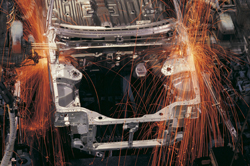New tool to expose welding defects
When considering the thousands of spot welds present in the make-up of a car, it is inevitable that some will need to be remade when the vehicle undergoes repair. Clearly, it is not possible to destructively test repair welds. Matching test samples could be made for some reassurance; however, there is currently no suitable method to ensure the integrity of welds going into service.The EU-funded project SPOTTRACK sought to meet this need and developed an automated spot weld inspection device. With a consortium of nine partners, the project first focused on assessing the market needs and then designed the device using a numerical model. The ultimate aim was to develop a lightweight and low-cost device as well as a probe that can access difficult regions and be used by a non-expert.Project partners pioneered the finite element modelling methods for ultrasound prediction. The models make it possible to study a large set of samples relatively inexpensively and provide more detailed insight. The modelling results provide visualisation of the sound field throughout the whole volume at any point in time during the weld test. This results in deeper understanding of the effects of the variables on the reliability of test results.To allow greater inspection resolution, SPOTTRACK uses an array probe and a multiplexer with a single pulser-receiver. The multiplexer allows signals to be collected, eliminating the need for expensive phased-array equipment. The project team also created a set of samples to ensure that the SPOTTRACK could reliably determine the quality of spot welds. Samples included good welds and a range of defective welds. The team used the data from these tests to develop novel signal processing algorithms for the inspection system.Novel algorithms that automatically identify the main reflections (from the backwall of the weld), intermediate reflections (in case of an undersized weld or defects in the weld), and certain parameters of the reflections such as arrival time and amplitude were developed. Using this information, the team could determine the thickness and the approximate size of the weld and decide whether the weld is defect free or not.Two prototype devices were developed, and field trials were conducted on cars that are under repair. Meeting a false call rate under 1 %, the SPOTTRACK device ensures safe vehicle repair.
Keywords
Spot weld, ultrasound, inspection device, weld defect, automotive repair



